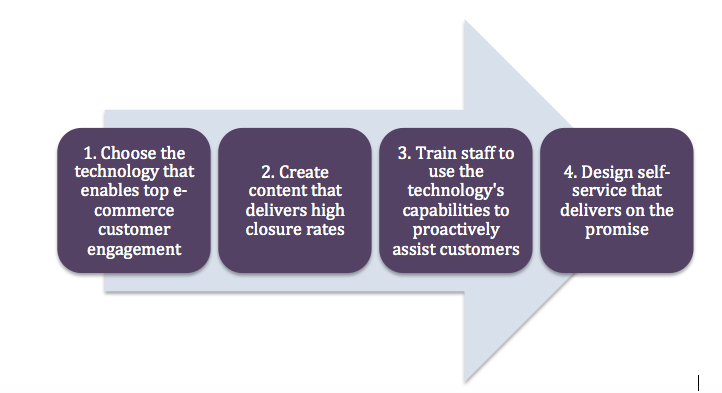In our new research on e-commerce customer engagement and its effect on driving revenue, we discovered four steps necessary for the creation of a fully engaged customer experience. Download an excerpt of the report here
Four steps to create engaging ecommerce customer experiences
Step 1. Choose the technology that enables top e-commerce customer engagement.
- It must be easy to start the buying process in one channel and finish in another.
- And customers must able be able to switch from one device to another and not lose the context of where they are in the purchasing process.
- Make sure the technology you choose allows you to proactively deliver contextual agent assistance during the purchase process.
- And in addition, the technology must have the ability to detect if customers need pre-purchase help and support.
- And then you must be able to send help to any channel and any device.
- Lastly, make sure that the technology has the capability to create performance reports viewable as a dashboard or downloadable as a report for analysis.
Step 2. Create content that delivers high closure rates.
- Whether you are creating knowledge base articles or marketing and advertising content, make sure that you know what works and what doesn’t work.
- This information will help to inform you so that you continually improve the content so that it drives purchases as well as self-service.
- Make sure you have the staff to deliver on this capability.
Step 3. Train staff to use the technology’s capabilities to proactively assist customers.
- While it is important to obtain technology that can assist customers in any channel and on any device, when human assistance is needed, make sure to train your agents or marketers so that they know how to use the technology and seamlessly provide the proactive help customers need to make purchasing decisions.
- This will not only help increase the lead conversion rates but also help increase customer loyalty, advocacy and long-term customer lifetime value and referrals.
- You want to be known as the company that provides help anytime, anywhere.
Step 4. Design self-service that delivers on the promise.
- Often, customers can help themselves if the technology or content is designed to anticipate customer issues and help solve them before the customer needs to reach out to the brand.
- Focusing on self-service capabilities is always a must for 80 percent of requests.
MYPOV:
Evaluate your organization. Does your organization follow at least a few of the four steps detailed above? Which ones do you need to implement and which ones do you need to improve on?
@drnatalie, VP and Principal Analyst, Constellation Research Covering Marketing, Sales and Customer Service to Deliver Amazing Customer Experiences
References:
Harris Poll Research and Primary Constellation Research




